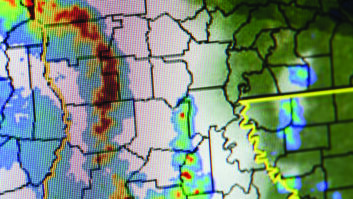WASHINGTON Emergency Alert System equipment manufacturers are being pushed to meet demand as the deadline for stations to begin receiving and transmitting Common Alerting Protocol messages nears.

Harold Price of Sage, center, is shown at the spring NAB Show. ‘We … told all of our suppliers that we’d have a sprint at the end, so everyone was prepared.’ Photos by Jim Peck
The FCC has set Sept. 30, 2011, as a hard date for broadcasters to be able to receive and transmit CAP-enabled alerts. CAP is an XML-based data format for exchanging all-hazard emergency alerts and public warnings over all kinds of networks. The commission could extend the deadline; however, it has not done so to date. The deadline already was extended once, from March 29, 2011. An FCC spokesman declined to comment on the possibility of another deadline extension.
Meanwhile, manufacturers are completing compliance reviews and final reports on equipment that passes the IPAWS conformity assessment. Those that do are eligible for posting on FEMA’s Responder Knowledge Base website at www.rkb.us.
While EAS equipment manufacturers contacted for this story declined to release sales figures, one source familiar with the industry said it’s likely that approximately 9,000 new CAP EAS encoders and decoders had been sold as of July.
“The number can’t be much below 7,000 right now. I’d say between 50 to 70 percent of EAS participants have received new units or have them on order,” the person said.
The industry veteran, who spoke on the condition of anonymity, estimates that of the 14,000 radio and TV EAS participants in this country, at least 3,000 likely share units with other stations in their clusters. That leaves a total market of about $25 million, he said.
Another industry executive, Harold Price, president of Sage Alerting Systems, said his company has seen the expected jump in sales this summer. To prepare, it placed advance orders for certain components that might have long lead times.

In July, Bill Robertson (also shown at NAB) estimated that Digital Alert Systems was processing hundreds of orders a week for broadcast radio and television customers.
“We also told all of our suppliers that we’d have a sprint at the end, so everyone was prepared,” said Price. “We use U.S. sources for our bare boards and build them up here. Soldering, electrical and visual inspection, sheet metal bending, punching, painting, final assembly and functional testing is all done in the U.S.” He added: “We selected U.S. suppliers that could handle the burst.”
Price, who believes the FCC deadline will not be changed, declined to release sales totals for Sage Alerting Systems but indicated they were on its projected target, “based on what we sold in 1996, increased competition and increased use of single Endecs controlling multiple stations.”
Digital Alert Systems manufactures emergency alert equipment including the DASDEC-II EAS/CAP messaging system. “We have seen orders for the DASDEC increase significantly,” said Bill Robertson, business development manager.
But, he continued, a number of broadcast groups large and small, have yet to place orders for CAP-compliant equipment.
“Several have waited for the Third Report & Order to be fleshed out — perhaps holding out that something would either change or create a discontinuity in current equipment that, if they purchased something before it was settled, might render the purchase obsolete and they’d be forced to buy something again,” Robertson said.
“Others have counted on further extensions, and a small number have told me directly they’ll take their chances with the FCC and won’t buy anything now.”
Digital Alert Systems began planning for the increase in production well in advance of the compliance deadline, Robertson said, anticipating the FCC’s desire to maintain the Sept. 30 deadline.
“All indications we have at present are the commission desires to keep the current date unless some truly extraordinary circumstances arise. Moreover, we believe now it would be harder to justify an extension since there are multiple products on the market that are IPAWS-conformant and FCC-certified.” The Integrated Public Alert and Warning System is the federal government’s new emergency messaging system, which will use multiple platforms for warning, including cell phones and the Internet along with traditional broadcast.
In July Robertson estimated that his company was processing hundreds of orders a week for broadcast radio and television customers. It added technical support staff to assist customers.
“These new devices and future interfaces are IP-based, so our new hires have extensive networking certifications and experience.”
Preparation
Darryl Parker, senior vice president of TFT Inc., which makes CAP-compliant encoder/decoders and converters, said his company has seen a “slight increase” in demand this summer.
“EAS participants are using this initiative to strengthen their EAS flexibility. Some are adding EAS encoders for additional streams or unique switching requirements, Parker said. “EAS participants seemingly are doing routine upgrading but not panicking in light of the deadline.”
TFT, which hired employees to strengthen support and test operations for the new equipment rollout, announced earlier this year that FEMA added the TFT model 3320 CAP-to-EAS converter to the conformity assessment list. The TFT converter is placed in front of an existing encoder/decoder.
CAP Converters Raise Questions
CAP converters are called “intermediary devices” by the commission. The validity of the converter approach has been a point of disagreement among EAS equipment manufacturers.
An intermediary device is integrated into an existing EAS system, essentially adding another receiver, according to the FCC. In its NPRM to change Part 11 rules, the commission asked whether it should allow such devices.
Some manufacturers dismiss converters as a cheap, temporary fix that will rely on original EAS equipment that could be 15 years old. Others believe converters are an economical solution for some stations.
Cost is a consideration for many broadcasters faced with replacing aging and non-compliant EAS equipment, one industry executive said, so converters may be attractive. Various vendor sites show the Gorman-Redlich CAP-DEC1 converter listing for $1,350, and TFT’s CAP-EAS converter 3320 at $1,600. New CAP-compliant encoder/decoders list for $2,695 or higher depending on configuration. But all of these prices are retail and don’t reflect presumed discounts being negotiated, particularly by group buyers.
Several EAS equipment manufacturers contacted by Radio World believe the FCC will allow intermediary devices once it is done reviewing public comments to its NPRM to change Part 11 rules (Docket 04-296).
“Absolutely the commission will allow CAP converter devices. I don’t know of any argument they can make against them,” said Darryl Parker, senior vice president of TFT Inc., which makes both converters and encoder/decoders.
Some manufacturers contend that a CAP-to-EAS converter may not be a viable application because it won’t be able to handle the “Governor Must Carry” message, which will be a part of an enhanced EAS system but isn’t yet standardized.
Parker said TFT’s Model 3320 CAP-to-EAS Converter will convert the Governor Must-Carry message.
FEMA earlier this year revised the tests for CAP 1.2 compliance to accommodate CAP converters, said Jim Gorman, president of Gorman-Redlich Mfg. Co. There are several CAP converters listed among the hardware that has passed the IPAWS conformity assessment. FEMA’s Responder Knowledge Base website is at www.rkb.us. The site provides access to product test results.
Bill Robertson, business development manager for Digital Alert Systems, said his company doesn’t offer converters.
“There has apparently been some pressure to allow intermediary devices with the thought that they either reduce cost or provide some other advantage over an integrated CAP EAS unit,” he said.
“We strongly believe there are some serious flaws to that logic. Even if the FCC allows these so-called intermediary devices, we do not feel they are a wise investment for both economic and operational reasons.
“Economically, the market pricing of basic EAS CAP encoder/decoders has been driven down to levels that are not too far off from an intermediary CAP-only box,” he continued.
“Further, there may be additional equipment needed for the converter box — like an IP router or relay cables or signal bypass units for to handle the Governor Must Carry. All these drive up the price of intermediary devices close to and (in one case we know) over the price of an integrated EAS CAP encoder decoder. So it’s not entirely clear a broadcaster will save money with an intermediary device — both in the short term and even less likely in the long-term.”
— Randy Stine
But still unclear is whether the FCC is going to allow stations to use CAP converter devices. The commission asked about allowing converters in its NPRM to change Part 11 rules (see sidebar). Initial public comments were due by July 20 to Docket 04-296 and reply comments by Aug. 4.
Such unanswered questions make Parker think the September compliance deadline will be moved again.
“I don’t think it will be maintained. Neither the FCC nor FEMA are ready for the deadline this fall. The FCC will not have issued a Report and Order on the open Further Notice of Proposed Rulemaking for Part 11” by then.
Gorman-Redlich Mfg. Co., which makes the CAP-DEC1 converter, has built up inventory to handle the demand this summer, said President Jim Gorman. He is another industry vet who believes the FCC will again extend the CAP deadline for participant compliance.
Meanwhile, equipment dealers contacted for this article also have seen a nice bump in sales numbers thanks to EAS purchases.
Matt Cauthen, sales manager for SCMS Inc., said, “Sales have been very brisk. We’ve been getting lots of questions about the deadline moving or availability of equipment.”
EAS equipment sales at BSW have been very good, said Sales Manager Shannon Nichols. “Broadcasters are especially interested in software upgrades if there are any changes made [to the EAS rules] down the road.”
As for delivery, Cauthen said SCMS had hundreds of CAP-ready EAS units on backorder but expected to have all cleared by mid-August. “No one is panicking. We expect to be able to fill all EAS equipment orders by the FCC’s deadline,” Cauthen said.
At BSW, orders for Sage gear placed in July were expected to ship by the end of August while Digital Alert Systems units were backordered about two weeks from date of order, Nichols said.
The stimulus effect of the EAS CAP process on broadcast equipment sales may be felt beyond the deadline.
In June, writing in a blog, Radio World U.S. Editor in Chief Paul McLane quoted Steve Davis, Clear Channel Radio’s senior vice president of engineering and capital management, saying Clear Channel had adopted a tiered approach to its rollout and that equipment was on order to arrive in July and August. Clear Channel chose Sage gear.
The initial phase involves 246 new units that will allow Clear Channel to meet the compliance deadline for all of its approximately 890 stations. “We will undertake a second rollout in 2012 to add enhanced functionality once the [Governor] ‘Must Carry’ rules are solidified,” Davis stated.










